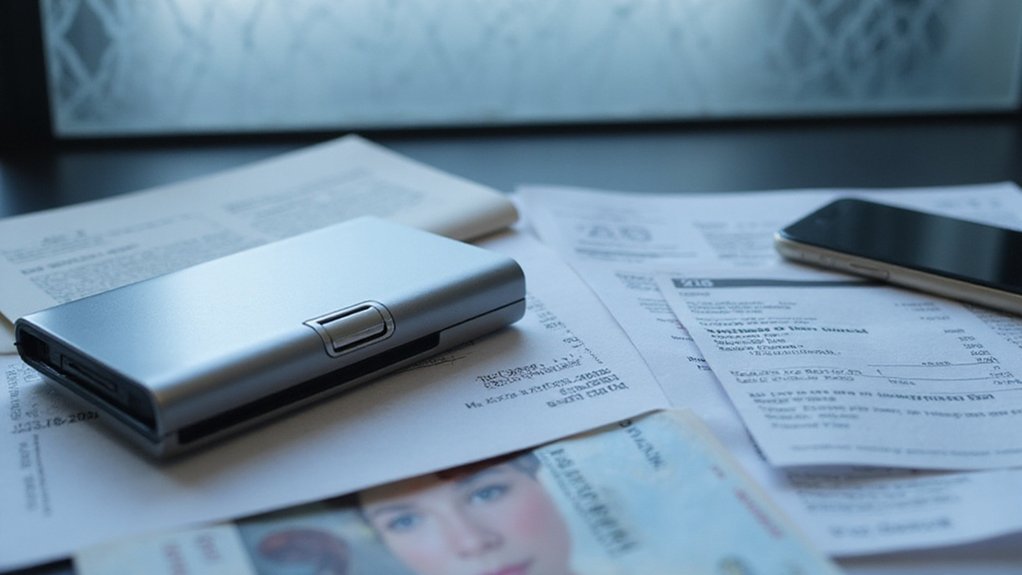KYC (“Know Your Customer”) in crypto represents the identity verification procedures centralized exchanges implement to comply with financial regulations. These processes—requiring users to submit personal information and official documentation—serve as bulwarks against money laundering, tax evasion, and terrorist financing. While creating onboarding friction that contradicts crypto’s libertarian roots, KYC differentiates legitimate operations from dubious ventures in an industry where, surprisingly, 69% of businesses operated without complete verification protocols as recently as 2019. The regulatory landscape continues evolving, with implications for every participant in the ecosystem.

The acronym KYC—standing for “Know Your Customer”—has become an unavoidable fixture in the cryptocurrency landscape, representing the collision between the industry’s libertarian origins and the realities of modern financial regulation.
This process, borrowed from traditional banking, requires centralized exchanges to verify the identities of their users through a series of documentation checks and verification steps that would make a bureaucrat blush with admiration.
At its core, KYC serves as the frontline defense against money laundering, tax evasion, and terrorist financing—those pesky problems that governments insist on addressing despite crypto’s promise of financial privacy.
Government’s eternal dilemma: embracing financial surveillance while crypto whispers seductive promises of private transactions.
The verification typically includes collecting users’ personal information (name, address, birth date) and government-issued identification, with some platforms implementing increasingly sophisticated biometric checks.
(One wonders if retinal scans and DNA samples might be next on the regulatory wish list.)
These requirements mirror those imposed on traditional financial institutions under frameworks like the Bank Secrecy Act, which treats crypto exchanges as money transmitters subject to the same scrutiny as Western Union or your neighborhood bank.
The stakes for non-compliance are considerable: substantial fines, regulatory actions, and the potential death knell for exchanges operating in jurisdictions where compliance is non-negotiable.
For users, KYC presents a paradoxical proposition.
While increasing friction during onboarding—sometimes delaying access to trading by days—it simultaneously serves as a quality signal that differentiates legitimate operations from potential scams.
The verification process functions as a trust mechanism in an industry still struggling with credibility issues.
According to a 2019 Coinfirm report, approximately 69% of crypto businesses lacked complete and transparent KYC procedures, highlighting the ongoing tension between regulatory demands and industry practices.
It’s important to note that while custodial wallets managed by VASPs require KYC compliance, non-custodial wallets are typically exempt from these requirements.
Perhaps the most significant challenge facing crypto KYC lies in its implementation across a global patchwork of regulatory environments, with exchanges forced to navigate contradictory requirements while maintaining operational efficiency.
This balancing act between regulatory compliance, user privacy, and security continues to shape the evolution of cryptocurrency services, transforming what began as an anonymous financial revolution into something increasingly resembling the system it sought to disrupt.
Frequently Asked Questions
Can I Use Crypto Anonymously Without Completing KYC?
Users can indeed operate in the crypto space anonymously via non-KYC platforms like MEXC or BingX, which permit trading without identity verification.
However, this privacy comes with significant trade-offs: regulatory uncertainty (platforms facing potential shutdown), limited consumer protections (good luck recovering funds after being scammed), transaction constraints, and blockchain transparency (those “anonymous” transactions remain permanently visible on public ledgers).
While technically possible, no-KYC crypto usage represents a calculated risk rather than true financial invisibility.
How Long Does the KYC Verification Process Typically Take?
KYC verification in crypto typically concludes within 10 minutes for automated systems, while manual reviews stretch to 24-48 hours (occasionally longer during market frenzies, when everyone suddenly discovers blockchain).
Processing time varies dramatically based on document quality, jurisdictional requirements, and verification level.
CoinDCX promises 10-minute automated completions; Kraken may take 5 days for business verification.
For expedited processing, submit pristine documentation and promptly address any follow-up requests—patience remains, ironically, a virtue in the “instant” digital asset space.
Which Crypto Exchanges Have the Simplest KYC Requirements?
Exchanges with minimal KYC hoops include KuCoin and Bybit, which employ threshold-based models allowing basic trading without document submission.
Decentralized platforms like Uniswap and dYdX fundamentally sidestep traditional verification entirely, requiring only wallet connections.
Regional players in emerging markets often accept mobile numbers for limited functionalities.
The verification landscape constantly shifts, however, as regulatory pressures mount worldwide, transforming yesterday’s KYC-light havens into tomorrow’s compliance-heavy gatekeepers—a financial game of whack-a-mole that never quite ends.
Are There Different KYC Levels for Different Transaction Amounts?
Indeed, crypto exchanges typically implement tiered KYC systems corresponding to transaction volumes.
Most platforms employ a graduated approach: minimal verification for modest amounts (perhaps just email and phone), intermediate verification for mid-range transactions (requiring ID documents), and thorough KYC for substantial sums (demanding proof of address, source of funds, and occasionally, face-to-face verification).
These thresholds vary by jurisdiction—the more stringent regulatory environments (looking at you, EU) imposing lower triggers for enhanced verification requirements.
Can I Be Rejected After Submitting KYC Documentation?
Yes, crypto platforms can certainly reject users after KYC submission.
Rejections commonly stem from document inconsistencies, mismatched personal information, poor-quality images, or flagged risk factors.
Users appearing on sanctions lists or submitting incomplete documentation face almost certain denial.
While most platforms allow for resubmission with corrected materials, persistent issues may result in permanent account closure—a sobering reminder that in the compliance-obsessed crypto landscape, verification is less a formality than a genuine evaluation.









